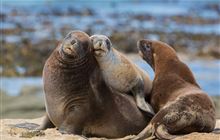Mixed results for sea lion breeding season
Archived content: This media release was accurate on the date of publication.
Introduction
A count of rāpoka/New Zealand sea lion pups born in the subantarctic islands this breeding season has shown mixed results for the species, DOC says.Date: 21 February 2019
Researchers have recently taken part in annual monitoring of rāpoka at Auckland Islands and Campbell Island, as part of the New Zealand Sea Lion Threat Management Plan.
“The results show that overall the population remains reasonably stable, but concerns remain about high pup mortality,” DOC’s Manager Marine Species and Threats, Ian Angus says.
1758 pups were born at the three breeding colonies at the Auckland Islands, 34 fewer than last year. On Campbell Island 704 pups were born, 30 fewer than last year.
“These numbers are not statistically significant to impact on the overall recent trend for the population, which remains reasonably stable overall,” Ian Angus says.
However, this year 54% of pups born on Campbell Island died, up from 23% last year. Last year’s mortality rate on Campbell Island was unusually low as the mortality range is generally between 40-60%.
On Auckland Island the mortality rate was consistently lower at 4.32% (4.91% in 2017/18).
“Previously much of the pup mortality came from pups drowning in naturally formed mudholes on Campbell Island. This year that wasn’t the case,” says Ian Angus.
“The dead pups showed signs of emaciation and exposure. Bad weather systems, prevalent during the early part of the breeding season, were the likely cause of this high mortality as last summer was much milder and drier.
“One of the goals of the Threat Management Plan is to grow the sea lion population, so it’s disappointing to see so many pups die,” Ian Angus says.
“The data shows that the species is not out of danger yet and that it’s important we work hard to ensure that all threats to these beautiful creatures are reduced in some way,” Ian Angus says.
“Research teams are still on Campbell and Auckland Islands carrying out necropsies and gathering further information to try to help us understand the cause of death. One of the many threats to sea lions is disease, specifically Klebsiella pneumoniae.”
Sea lions are managed through the New Zealand Sea Lion Threat Management Plan, which sets out a five-year programme of engagement, targeted research, direct mitigation, and regular monitoring at all known breeding sites.
Background information
|
|
2018/2019 |
2017/2018 |
||||
|---|---|---|---|---|---|---|
|
Total pups born |
Dead |
Mortality |
Total pups born |
Dead |
Mortality |
|
|
Auckland Is |
1758 |
76 |
4.32% |
1792 |
88 |
4.91% |
|
Campbell Is |
704 |
380 |
53.97% |
734 |
168 |
22.88% |
For more information: sea lion research and fieldwork
The New Zealand sea lion is classified as “Nationally Critical”, the highest risk classification. Ninety eight percent of breeding occurs on Campbell and the Auckland Islands, but there are also small populations on the lower South Island and Stewart Island.
It’s estimated the New Zealand sea lion populations is around 12,000.
Sea lions face a range of natural and human threats, such as disease, fishing, environmental change, food availability, and predation by sharks. Disturbance by beachgoers and dogs along the mainland coastline also impact on the population’s ability to recolonise.
Contact
For media enquiries contact:
Email: media@doc.govt.nz

